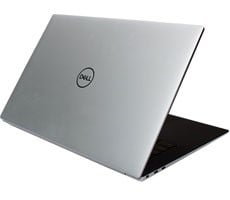Dell Precision M3800 Mobile Workstation Review
Assuming you opted for the optional 4K Ultra HD touch display with second generation IGZO technology, one of those reasons is more on-screen real estate. A lot more. The M3800 equipped as such pushes a 3840x2160 resolution, which equates to over 3 million more pixels than a MacBook Pro with Retina display, or a 59 percent bump. It also boasts up to twice as much storage space, longer battery life, and ISV certification, to point out a few of Dell's bragging points.
Comparisons aside, the M3800 tries to entice graphic designers, engineers, and other high-end users who often work in the field with a true mobile workstation that's both sufficiently equipped to handle professional grade workloads and is thin and light to boot. In fact, Dell claims the M3800 is the world's thinnest and lightest 15-inch mobile workstation, and at 14.65 (W) by 10 (D) by 0.31 to 0.71 (H) inches with a starting weight of 4.15 pounds, we won't argue the point.
Certainly there are lighter and thinner laptops out there, but they lack the features and parts that would allow them entry into the mobile workstation category. The aforementioned ISV certification is one them, and on the hardware side, mobile workstations typically bring professional graphics to the job site. In this case, the M3800 gets its pixel pushing muscle from an NVIDIA Quadro K1100M GPU with 2GB of GDDR5 memory riding on a 128-bit interface.
Other notable specs include an Intel Core i7-4712HQ quad-core processor, 16GB of DDR3L memory, and a 256GB mSATA solid state drive rounding out the performance foundation.
Before we hit the ground running with the refreshed M3800, let's have a look at the full spec sheet.
|
| Processor | Intel Core i7-4712HQ (6MB cache, 2.3GHz to 3.3GHz) |
| Operating System | Windows 8.1 64-bit |
| Graphics | Intel HD Graphics 4600 + NVIDIA Quadro K1100M w/ 2GB GDDR5 |
| Memory | 16GB DDR3L 1600MHz DRAM (2x8GB) |
| Display | 15.6-inch UltraSharp IGZO Ultra HD 4K (3840x2160) Touch |
| Storage | 256GB Samsung mSATA SSD |
| Optical | N/A |
| Ethernet | Gigabit Ethernet via USB 3.0 adapter |
| Wireless Connectivity | Intel Dual Band Wireless-AC 7260 + Bluetooth 4.0 |
| Interface (Left) |
HDMI Thunderbolt 2.0 / mini DisplayPort USB 3.0 w/ Powershare Headset jack |
| Interface (Right) | 3-in-1 card reader (SD, SDHC, SDXC) USB 2.0 w/ Powershare USB 3.0 w/ Powershare |
| Webcam | 720p w/ dual array digital microphones |
| Battery | 61Whr (6-cell) non-replaceable |
| Dimensions | 14.65 (W) x 10 (D) x 0.31-0.71 (H) inches |
| Weight | 4.15 pounds |
| Manufacturer Warranty | 1-year Pro Support with Next Business Day Onsite Service |
| Pricing: | $2,234.30 (as configured) |
One of the new additions to the M3800 is a Thunderbolt 2 port. This gives users access to transfer speeds of up to a theoretical 20Gbps. Real world speeds won't go quite as high, but it's still much faster than USB 3.0, and more importantly, Thunderbolt 2 allows for the simultaneous viewing/editing and backing up of raw 4K video.
This is made possible by Thunderbolt 2's dual 20Gbps bi-directional channels. Compared to the original Thunderbolt spec, there's no increase in overall bandwidth, but instead of four independent 10Gbps channels (two upstream and two downstream), Thunderbolt 2 can move up to 20Gbps of data upstream and downstream at the same time. Hence the ability to view and edit raw 4K video while simultaneously writing it to a storage device, along with a theoretical transfer rate of up to 1,500MB/s).
So far it looks as though the M3800 is a solid contender in the mobile workstation space. Follow along as we take a closer look and run this system through our gauntlet of benchmarks.








